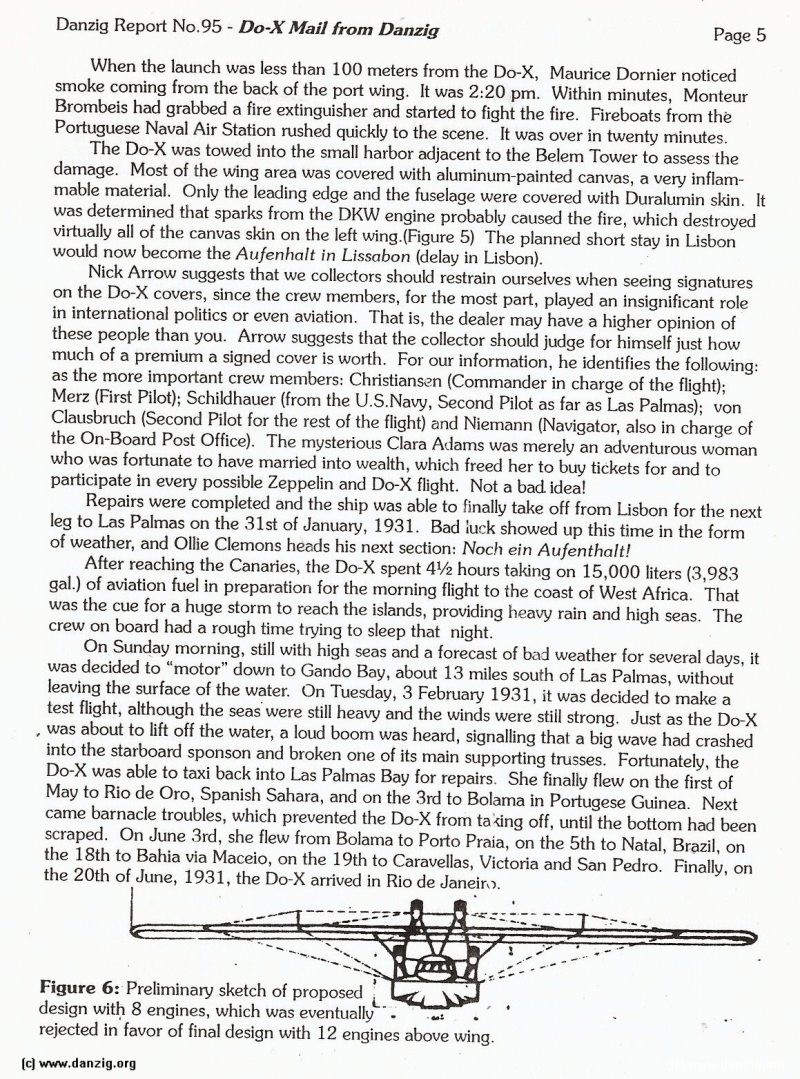
When the launch was less than 100 meters from the Do-X, Maurice Dornier noticed smoke coming from the back of the port wing. It was 2:20 pm. Within minutes, Monteur Brombeis had grabbed a fire extinguisher and started to fight the fire. Fireboats from the Portuguese Naval Air Station rushed quickly to the scene. It was over in twenty minutes.
The Do-X was towed into the small harbor adjacent to the Belem Tower to assess the damage. Most of the wing area was covered with aluminum-painted canvas, a very inflamm able material. Only the leading edge and the fuselage were covered with Duralumin skin. It was determined that sparks from the DKW engine probably caused the fire, which destroyed virtually all of the canvas skin on the left wing.(Figure 5) The planned short stay in Lisbon would now become the Aufenhalt in Lissabon (delay in Lisbon).
Nick Arrow suggests that we collectors should restrain ourselves when seeing signatures on the Do-X covers, since the crew members, for the most part, played an insignificant role in international politics or even aviation. That is, the dealer may have a higher opinion of these people than you. Arrow suggests that the collector should judge for himself just how much of a premium a signed cover is worth. For our information, he identifies the following: as the more important crew members: Christians,’n (Commander in charge of the flight); Merz (First Pilot); Schildhauer (from the U.S.Navy, Second Pilot as far as Las Palmas); von Clausbruch (Second Pilot for the rest of the flight) and Niemann (Navigator, also in charge of the On-Board Post Office). The mysterious Clara Adams was merely an adventurous woman who was fortunate to have married into wealth, which freed her to buy tickets for and to participate In every possible Zeppelin and Do-X flight. Not a bad idea!
Repairs were completed and the ship was able to finally take off from Lisbon for the next leg to Las Palmas on the 31st of January, 1931. Bad uck showed up this time in the form of weather, and Ollie Clemons heads his next section: Noch em Aufenthalt!
After reaching the Canaries, the Do-X spent 4/2 hours taking on 15,000 liters (3,983 gal.) of aviation fuel in preparation for the morning flight to the coast of West Africa. That was the cue for a huge storm to reach the islands, providing heavy rain and high seas. The crew on board had a rough time trying to sleep that night.
On Sunday morning, still with high seas and a forecast of bad weather for several days, it was decided to “motor” down to Gando Bay, about 13 miles south of Las Palmas, without leaving the surface of the water. On Tuesday, 3 February 1931, it was decided to make a test flight, although the seas were still heavy and the winds were still strong. Just as the Do-X was about to lift off the water, a loud boom was heard, signalling that a big wave had crashed into the starboard sponson and broken one of its main supporting trusses. Fortunately, the Do-X was able to taxi back into Las Palmas Bay for repairs. She finally flew on the first of May to Rio de Oro, Spanish Sahara, and on the 3rd to Bolama in Portugese Guinea. Next came barnacle troubles, which prevented the Do-X from ta dng off, until the bottom had been scraped. On June 3rd, she flew from Bolama to Porto Praia, on the 5th to Natal, Brazil, on the 18th to Bahia via Maceio, on the 19th to Caravellas, Victoria and San Pedro. Finally, on the 20th of June, 1931, the Do-X arrived in Rio de Janeir.
Figure 6: Preliminary sketch of proposed design with 8 engines, which was eventually rejected in favor of final design with 12 engines above wing.
Danzig Report Vol. 1 - Nr. 95 - April - May - June - 1997, Page 5.
Hits: 4136
Added: 19/07/2015
Copyright: 2025 Danzig.org

